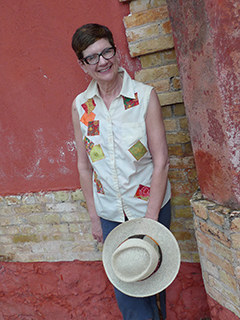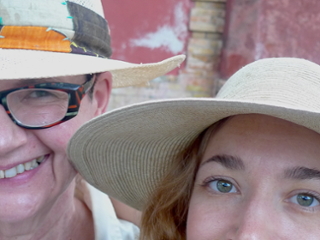Janet Berlo
Dr. Janet Berlo Retires After 23 Years Teaching in Visual and Cultural Studies, Art and Art History, and the Susan B. Anthony Institute for Gender, Sexuality, and Women's Studies

For 23 glorious years, Janet Berlo has been at the heart of Visual and Cultural Studies (VCS). She first joined the University of Rochester as the Susan B. Anthony Professor of Gender Studies and Professor of Art History in 1997, having received her PhD from Yale in 1980. While teaching, advising, and informally mentoring generations of VCS students, she has written, co-authored, and co-edited a dozen books, including four textbooks and a brilliant memoir, Quilting Lessons. Her forthcoming book on misrepresentations and falsifications in the world of Native American art will participate in some of the liveliest discussions being had in our field writ large. To honor Janet’s contributions to VCS over the years, we have asked two of her former advisees and alumni of the program, Jessica Horton (University of Delaware) and Norman Vorano (Queen’s University), to pay tribute to her here.
Jess Horton, University of Delaware

I met Dr. Janet Catherine Berlo when I was a worshipful undergrad working part-time at the SANA Art Foundation, a non-profit dedicated to public education about the arts of Africa, Oceania, and the Americas in San Diego. Our esteemed guest delivered a vibrant, funny lecture about the collages of her friend and collaborator, the Lakota artist Arthur Amiotte. There was not a hint of pathos in the art, nor in the words she wrapped around it—all was in vivid, living color. At the end, an elderly man in the audience stood up, sobbing. “I can’t believe what we did to the Indians!” he wailed. Janet didn’t mince words, then or ever, but I recall admiring how generous she was when exasperated.
Sly wit, no-nonsense brilliance, uncompromising honesty, expansive kindness, surrounded by a riotous palette: These are the qualities I love most in my extraordinary mentor. The distance and dread often conjured by the title, “dissertation advisor,” was absent from our relationship; after a few semesters of coursework in Visual and Cultural Studies, Janet invited a deepening friendship and collaboration. We were happy holed up together in a snowstorm in Stephanie Frontz’s house near Santa Fe, hyped on chile and chocolate, co-authoring an article on Indigenous art and ecology for the Taylor & Francis greatest hits list. We were equally content with sparse words in the Virgin Islands, climbing impossible stairways in the rain, recovering from life’s traumas that rupture the gold-standard of “productivity” in academia.
Recently, mired in a terrifying bout of writer’s block in the wake of climate change, Trump, and the tenure-track, I reread the book that brought me to the University of Rochester in 2007. It was neither edition of Native North American Art, the lucid textbook that has inspired generations of undergrads to declare art history majors, nor The Early Years of Native North American Art History: The Politics of Scholarship and Collecting, the foundation of every course I teach in the field, nor Spirit Beings and Sun Dancers: Black Hawk’s Vision of the Lakota World, the exquisite publication that altered how we understand spirituality and crisis. I reached in desperation for Quilting Lessons: Notes from the Scrap Bag of a Writer and Quilter, a slim trade book about depression and patchwork. “I begin to cry. Not big sobs. Just soundless tears, seeping from beneath my closed eyelids. I stalk into the living room and huddle miserable on the couch. ‘My academic life is over,’ I think to myself savagely. ‘I can’t even understand simple sentences anymore.’”[1] Then, “Teal and midnight blue patterns, cobalt stripes, a sprigged hyacinth. Black with jagged ultramarine swirls. I would arrange them next to each other, add two, subtract one. … I see a vivid image of myself sheltered under a big quilt or surrounded by swaths of fabric, hiding within their protective coloration.”[2] Descended from generations of women who piece for cover and pleasure, it is no wonder that I embraced Janet as chosen kin.
A couple of months into her so-called retirement, Janet continues to shape the field of Native North American art with shiny books and exhibitions. Equally she takes up the tireless, unseen labor of reading others’ drafts (sometimes, incomprehensibly, the same day they are sent) and writing the kind of informal, three-sentence email introductions that make good things happen. “Grandma emerita, that is me!” she jokingly signed at the end of a recent email concerning the dissertation of a talented student of mine who she has never met in person. For most scholars of Janet’s stature, steering a bright new generation through an opportunity desert amid accelerating political and ecological crises is an alien task. Her inexhaustible gift as a mentor is the license to wordlessly cry and create, to pause and watch with wonderment “the unfurling of a new part of me.”[3]
Jessica L. Horton is an associate professor and director of the Curatorial Track PhD in Art History at the University of Delaware and the 2021–2022 Distinguished Scholar for the Lunder Institute for American Art Research Fellows Program. Her research and teaching emphasize the centrality of Native North American art and ecologies to a global story of modernity. Her first book, Art for an Undivided Earth: The American Indian Movement Generation (Duke University Press, 2017), traces the impact of Indigenous spatial struggles on artists working internationally since the 1970s.
[1] Janet Catherine Berlo, Quilting Lessons: Notes from the Scrap Bag of a Writer and Quilter (Lincoln, NE: Bison Books, 2001), 1–2.
[2] Ibid., 3.
[3] Ibid., 2.
Norman Vorano, Queen's University
Thoughts on Janet Berlo’s Retirement
On this occasion of Janet Berlo’s retirement, I’m thinking quite a lot about her font, or more precisely, her typeface.
Yes, “her” typeface.
For as long as I’ve known her, since 1999, it’s been Comic Sans.
It takes a special kind of person to pull off Comic Sans, and I assure you that nobody does it like Janet Berlo. Be it a book manuscript, a catalogue essay, or a mundane administrative memo, if it began on Janet’s word processor, it began its life in the unassumingly casual garb of Comic Sans. I quietly savour the irony in knowing that several “field-defining” books and barrier breaking essays in Native American art history—rigorous, important publications—were born in Comic Sans, a typeface that is often scorned or ridiculed by the humorless and self-important. I also love that Janet has never once felt the need to explain why she uses Comic Sans either. In this I have learned a valuable life lesson: live with confidence, without apology, just be yourself and don’t worry too much about what others think. But I have also discerned a more tricksterish strategy at work here, which tells you something about Janet’s way of being-in-the-world. Allow me to explain.
Several years ago, the filmmaker Errol Morris (a Baskerville man, by the way) teamed up with the New York Times (Georgia since 2007) to do an experiment to see if typeface design contributes to the “believability” of a statement. It turns out that it does, and moreover, Comic Sans is actually one of the least trustworthy typefaces. I think Morris’ experiment misses something very important. Comic Sans, unlike other more august or grandiloquent typefaces, doesn’t sternly demand blind trust from the reader. Instead, it says, “hey, sit down, relax, get comfortable,” as if to invite the reader to be receptive to new ideas. Janet personifies the spirit and—dare I say potency—of Comic Sans: the playful and approachable exterior creates an intimacy and interpersonal connection that invariably leads to invention, sophisticated thought, and boundless creativity. To me, that’s Janet.
Janet has been, and continues to be, a mentor, teacher, colleague, critic, reader, confidant, supporter, consigliere, tastemaker, and, above all, a dear friend. She has generously opened professional doors for so many students and has turned us on to books, colleagues, and ideas that have transformed our lives. Certainly, that has been the case with me. Above all, she has showed us that the world is both bigger and smaller than we ever imagined it to be, and that we must listen to our hearts and follow our passions wherever they lead us. I have so many vivid and fond memories of Janet—too many to share here—but I will say that I know of no other person who could so seamlessly pivot in conversation from 19th century Plains beadwork, to “work-life” balance, to twentieth-century American quilts, to Postclassical Teotihuacan, and beyond. Janet has spent her career colouring outside the lines; she doesn’t fit into a neat box; she doesn’t do what’s expected—rather like Comic Sans. As I said, it takes a special person to pull it off.
Janet, long may you continue to follow your heart, write, create, and shine. Congratulations on this well-deserved moment. I am so deeply privileged to have been a part of your professional journey through the academe, and in life.
Norman Vorano is the Head of the Department of Art History and Art Conservation, Queen’s University at Kingston, where is also an Associate Professor of Art History. He publishes widely in Indigenous art and museum culture, and was a Curator of Inuit Art at the Canadian Museum of History. Vorano is an alumnus of the Program in Visual and Cultural Studies at the University of Rochester and, very proudly, the first doctoral student of Professor Janet Berlo.
